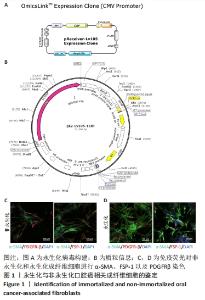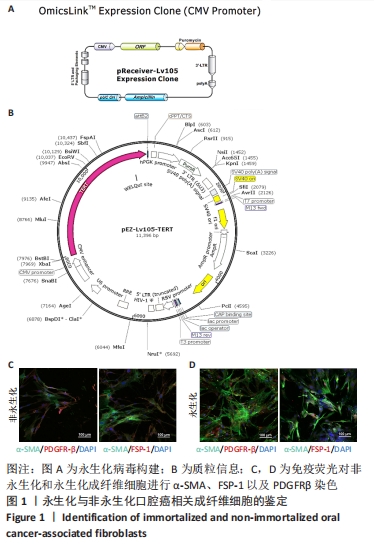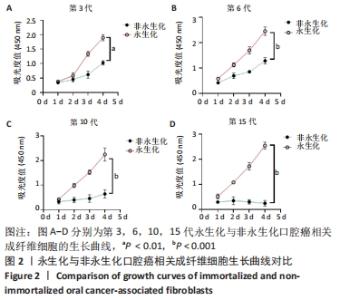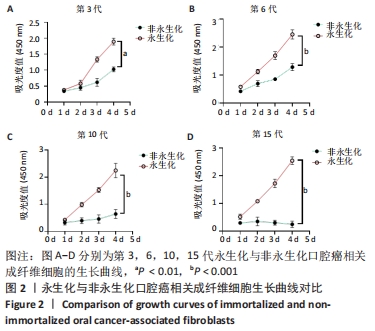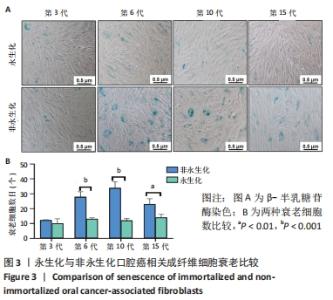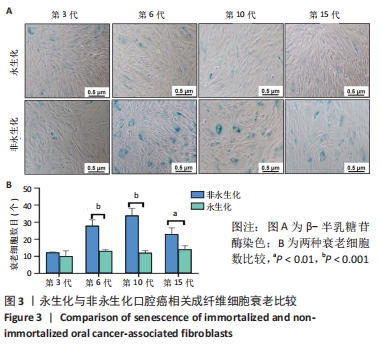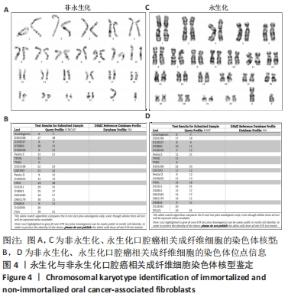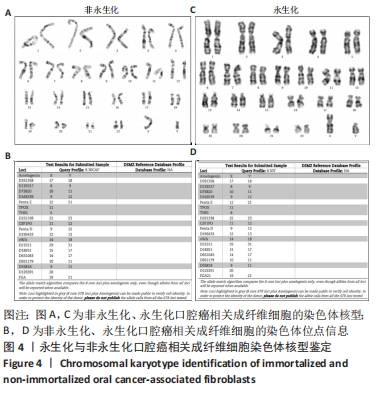[1] PATEL SG, AMIT M, YEN TC, et al. Lymph node density in oral cavity cancer: results of the International Consortium for Outcomes Research. Br J Cancer. 2013;109(8):2087-2095.
[2] ÖZDEMIR BC, PENTCHEVA-HOANG T, CARSTENS JL, et al. Depletion of Carcinoma-Associated Fibroblasts and Fibrosis Induces Immunosuppression and Accelerates Pancreas Cancer with Reduced Survival. Cancer Cell. 2015;28(6):831-833.
[3] DOMEN A, QUATANNENS D, ZANIVAN S, et al. Cancer-Associated Fibroblasts as a Common Orchestrator of Therapy Resistance in Lung and Pancreatic Cancer. Cancers (Basel). 2021;13(5):987.
[4] ZHANG F, CUI JY, GAO HF, et al. Cancer-associated fibroblasts induce epithelial-mesenchymal transition and cisplatin resistance in ovarian cancer via CXCL12/CXCR4 axis. Future Oncol. 2020;16(32):2619-2633.
[5] DOTTO GP. Multifocal epithelial tumors and field cancerization: stroma as a primary determinant. J Clin Invest. 2014;124(4):1446-1453.
[6] BALDI L, HACKER DL, ADAM M, et al. Recombinant protein production by large-scale transient gene expression in mammalian cells: state of the art and future perspectives. Biotechnol Lett. 2007;29(5):677-684.
[7] DAUER P, ZHAO X, GUPTA VK, et al. Inactivation of Cancer-Associated-Fibroblasts Disrupts Oncogenic Signaling in Pancreatic Cancer Cells and Promotes Its Regression. Cancer Res. 2018;78(5):1321-1333.
[8] YI Y, ZENG S, WANG Z, et al. Cancer-associated fibroblasts promote epithelial-mesenchymal transition and EGFR-TKI resistance of non-small cell lung cancers via HGF/IGF-1/ANXA2 signaling. Biochim Biophys Acta Mol Basis Dis. 2018;1864(3):793-803.
[9] LIU M, SONG W, HUANG L. Drug delivery systems targeting tumor-associated fibroblasts for cancer immunotherapy. Cancer Lett. 2019; 448:31-39.
[10] GRUNBERG N, PEVSNER-FISCHER M, GOSHEN-LAGO T, et al. Cancer-Associated Fibroblasts Promote Aggressive Gastric Cancer Phenotypes via Heat Shock Factor 1-Mediated Secretion of Extracellular Vesicles. Cancer Res. 2021;81(7):1639-1653.
[11] BAKER AT, ABUWARWAR MH, POLY L, et al. Cancer-Associated Fibroblasts and T Cells: From Mechanisms to Outcomes. J Immunol. 2021;206(2):310-320.
[12] SUBRAMANIAM KS, OMAR IS, KWONG SC, et al. Cancer-associated fibroblasts promote endometrial cancer growth via activation of interleukin-6/STAT-3/c-Myc pathway. Am J Cancer Res. 2016;6(2):200-213.
[13] BORRIELLO L, NAKATA R, SHEARD MA, et al. Cancer-Associated Fibroblasts Share Characteristics and Protumorigenic Activity with Mesenchymal Stromal Cells. Cancer Res. 2017;77(18):5142-5157.
[14] LI Z, ZHOU J, ZHANG J, et al. Cancer-associated fibroblasts promote PD-L1 expression in mice cancer cells via secreting CXCL5. Int J Cancer. 2019;145(7):1946-1957.
[15] ZHAO X, DING L, LU Z, et al. Diminished CD68+ Cancer-Associated Fibroblast Subset Induces Regulatory T-Cell (Treg) Infiltration and Predicts Poor Prognosis of Oral Squamous Cell Carcinoma Patients. Am J Pathol. 2020;190(4):886-899.
[16] DING L, REN J, ZHANG D, et al. A novel stromal lncRNA signature reprograms fibroblasts to promote the growth of oral squamous cell carcinoma via LncRNA-CAF/interleukin-33. Carcinogenesis. 2018;39(3): 397-406.
[17] ZELTZ C, PRIMAC I, ERUSAPPAN P, et al. Cancer-associated fibroblasts in desmoplastic tumors: emerging role of integrins. Semin Cancer Biol. 2020;62:166-181.
[18] TAN JJ, WANG L, MO TT, et al. Establishment of Immortalized Laryngeal Epithelial Cells Transfected with Bmi1. Cell Transplant. 2020; 29:963689720908198.
[19] KAMADA M, KUMAZAKI T, MATSUO T, et al. Establishment of ultra long-lived cell lines by transfection of TERT into normal human fibroblast TIG-1 and their characterization. Cell Biol Int. 2012;36(6):519-527.
[20] YOU S, MOON JH, KIM TK, et al. Cellular characteristics of primary and immortal canine embryonic fibroblast cells. Exp Mol Med. 2004; 36(4):325-335.
[21] PETKOV S, KAHLAND T, SHOMRONI O, et al. Immortalization of common marmoset monkey fibroblasts by piggyBac transposition of hTERT. PLoS One. 2018;13(9):e0204580.
[22] VERED M, DAYAN D, YAHALOM R, et al. Cancer-associated fibroblasts and epithelial-mesenchymal transition in metastatic oral tongue squamous cell carcinoma. Int J Cancer. 2010;127(6):1356-1362.
[23] MARSH D, SUCHAK K, MOUTASIM KA, et al. Stromal features are predictive of disease mortality in oral cancer patients. J Pathol. 2011; 223(4):470-481.
[24] THOMAS D, RADHAKRISHNAN P. Tumor-stromal crosstalk in pancreatic cancer and tissue fibrosis. Mol Cancer. 2019;18(1):14.
[25] BARRETT R, PURÉ E. Cancer-associated fibroblasts: key determinants of tumor immunity and immunotherapy. Curr Opin Immunol. 2020;64: 80-87.
[26] KOBAYASHI H, ENOMOTO A, WOODS SL, et al. Cancer-associated fibroblasts in gastrointestinal cancer. Nat Rev Gastroenterol Hepatol. 2019;16(5):282-295.
[27] WU Y, ZHANG Y, MISHRA A, et al. Generation of induced pluripotent stem cells from newborn marmoset skin fibroblasts. Stem Cell Res. 2010;4(3):180-188.
[28] LI Q, TANG L, ROBERTS PC, et al. Interferon regulatory factors IRF5 and IRF7 inhibit growth and induce senescence in immortal Li-Fraumeni fibroblasts. Mol Cancer Res. 2008;6(5):770-784.
[29] MAISHI N, KIKUCHI H, SATO M, et al. Development of Immortalized Human Tumor Endothelial Cells from Renal Cancer. Int J Mol Sci. 2019; 20(18):4595.
[30] BALDUCCI L, BLASI A, SALDARELLI M, et al. Immortalization of human adipose-derived stromal cells: production of cell lines with high growth rate, mesenchymal marker expression and capability to secrete high levels of angiogenic factors. Stem Cell Res Ther. 2014;5(3):63.
[31] VIDALE P, MAGNANI E, NERGADZE SG, et al. The catalytic and the RNA subunits of human telomerase are required to immortalize equid primary fibroblasts. Chromosoma. 2012;121(5):475-488.
[32] KUMAZAKI T, KURATA S, MATSUO T, et al. Establishment of human induced pluripotent stem cell lines from normal fibroblast TIG-1. Hum Cell. 2011;24(2):96-103.
[33] YUAN J, YANG BM, ZHONG ZH, et al. Upregulation of survivin during immortalization of nontransformed human fibroblasts transduced with telomerase reverse transcriptase. Oncogene. 2009;28(29):2678-2689.
[34] HASHIMOTO H, SUDA Y, MIYASHITA T, et al. A novel method to generate single-cell-derived cancer-associated fibroblast clones. J Cancer Res Clin Oncol. 2017;143(8):1409-1419.
|
